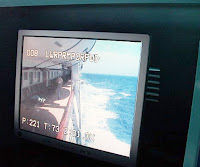
One of the great things about travel blogging is that it not allows you to talk about where you have
been, but also say what’s on your
mind.
Our visit to Colonia del Sacramento was a case in point. We’ve told you a bit about the sites, but today we want to concentrate on one we
didn’t mention, which has a bit more meaning for all of us. We refer, of course, to the Montevideo
Train Station.
We saw this for about four minutes total, going and coming, but in the end, it may have had more of an impact on us than the rest of the day
combined.
Take a look at the pictures – it’s pretty cool – although not in the league of the Train Station in York, for those who have seen it. In the 19th century, British influence in Uruguay was at its peak and this edifice was built, along with an accompanying railroad line. Subsequently, rail transport went out of the fashion, and the station has laid closed and deserted for a number of years. Andrea, our guide, noted that every once in a while, someone suggests revitalizing the station for this or another use, but that nothing has happened to date.

OK, forget Uruguayan Montevideo. Let’s talk about us. Let’s talk about you. We feel that the Train Station is a metaphor for
all of us, representing something that already exists in our lives, but which has been left abandoned. Could it be a novel, which you
started, but never finished? Might it be an under-utilized talent for playing piano and/or painting? Or perhaps a beautiful piece of furniture that you inherited, which is up in the attic? Or your grandfather’s collection of postcards, which lie forgotten in a drawer?
The point is that every one of us has a thing of beauty or a talent to offer which can
match the Montevideo Train Station, but which has been equally
underutilized. We’re not sure about Uruguay’s excuse, but what’s
our excuse? If we’re ever asked to account for stewardship, what are we going to say? It was too much work? We didn’t have time? We weren’t appreciated enough?
The Train Station still sits unused waiting its day. When we get home, we hope to get to work on ours….
More thoughts and a request for prayer for Uruguay – this time from Mary:
On the day that we were in Uruguay, I thought our guide had a kind of sad, resigned honesty. She wanted to tell the truth, even if it hurt, and it felt as if Uruguay were hurting in some way. While it was obvious that the people were hard working, there was a kind of sadness over the country, which seemed to bleed into the countryside, despite the incredibly beautiful day. In the afternoon, as we were riding back on the bus from our tour of Colonia del Sacramento, our guide made mention of the “extermination.” I asked her, “Could you tell us what you mean?” She dove in bravely, tackling the subject. Like other countries around the world, including the United States, Uruguay had its problems with the natives or indigenous peoples. While I don’t remember all the specifics, suffice it to say that in the 1800’s there was a group of Indians (500 to 2000), who were nomads. The ruling class worked with them for a number of years with the goal that the Indians would leave off their nomadic ways, but without success. Finally, in frustration, they drove this small band into a river – still called Saucerpuedes [?] (“save yourself if you can”). Four
did save themselves, while the rest drowned. The survivors were sent off to Europe to determine if they
were human. Once this was “established”, they were pawned off on a circus sideshow and didn’t survive terribly long.
It was a sad story, but you say all countries have sad stories and they don’t seem to be held back by them. But then, they are not Uruguay – a small country surrounded by its affluent neighbors and saddled with this terrible load of guilt. Would you please pray for Uruguay – that the message of the gospel would come to them and that they would come to know “liberty from guilt through Christ and be transformed to new life in Him"?
 One of the great things about a sea voyage is that it is what you make it You can spend all your time in your room, feeding the slot machines, or stuffing your face in any one of the number of restaurants. Or you can use the opportunity to learn a bit more.
One of the great things about a sea voyage is that it is what you make it You can spend all your time in your room, feeding the slot machines, or stuffing your face in any one of the number of restaurants. Or you can use the opportunity to learn a bit more.



































































